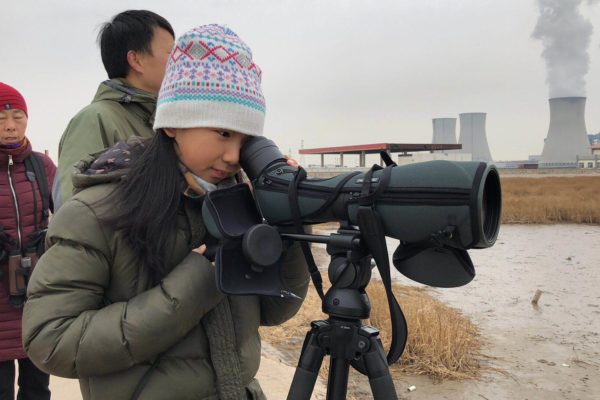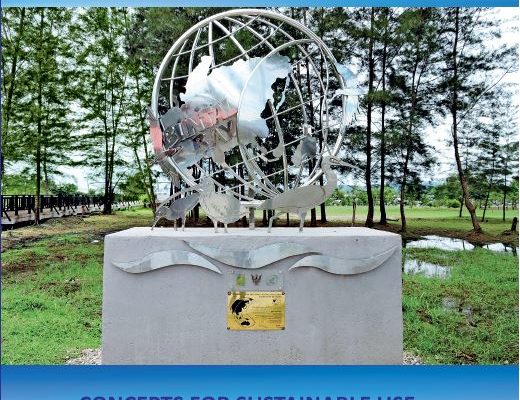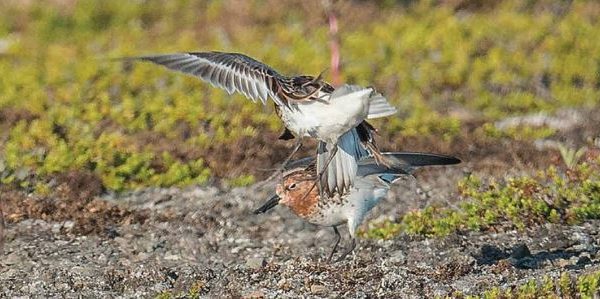-
East Asian-Australasian Flyway Partnership Vacancy Announcement – IT Consultant
EAAFP is seeking highly motivated individuals for the positions of IT and Website Specialist. Under the supervision of the Communication Officer and the Chief Executive of EAAFP, consultants will support the implementation of the Communication, Education, Participation and Awareness (CEPA) programme and activities of the Partnership. Here is the link for the position description, requirements and selection criteria. Position: Consultant (IT consultant) Type of contract: 6 months contract Work percentage: 100% (full time) Languages: English and Korean Deadline: Expected start date: as soon as possible How to apply Those who are interested in working for an international organization in environment and nature conservation can send the set of documents to secretariat@eaaflyway.net with the EAAFP Job Application Form. Posting expires: Once the position is filled Email: secretariat@eaaflyway.net Location: G-Tower, Songdo, Incheon, Republic of Korea Please submit, CV/résumé EAAFP_Job_Application_Form A personal statement on the reason for applying and your career goal (up to one page) A reference letter (when requested) If you have any questions, please send an email to danhak.gu@eaaflyway.net
Continue reading -
East Asian-Australasian Flyway Partnership Vacancy Announcement – Communication Consultant
EAAFP is seeking highly motivated individuals for the positions of Communication Specialist. Under the supervision of the Communication Officer and the Chief Executive of EAAFP, consultants will support the implementation of the Communication, Education, Participation and Awareness (CEPA) programme and activities of the Partnership. Here is the link for the position description, requirements and selection criteria. Position: Consultant (Communication consultant) Type of contract: July - December 2018 (6 months) Work percentage: 100% (full time) Languages: English and Korean Deadline: 1 July 2018 Expected start date: July 2018 How to apply Those who are interested in working for an international organization in environment and nature conservation can send the set of documents to secretariat@eaaflyway.net with the EAAFP Job Application Form. Posting expires: Once the position is filled Email: secretariat@eaaflyway.net Location: G-Tower, Songdo, Incheon, Republic of Korea Please submit, CV/résumé EAAFP_Job_Application_Form A personal statement on the reason for applying and your career goal (up to one page) A reference letter (when requested) If you have any questions, please send an email to danhak.gu@eaaflyway.net
Continue reading -
Ten Countries Agree The “HENGSHUI DECLARATION” To Save Baer’s Pochard (Aythya baeri) From Extinction In The Wild
21 MARCH 2018 ©Luo Jianhong On 19-20 March 2018, delegates from ten countries gathered at Hengshui Lake National Nature Reserve, in Hebei Province, China, for the first international workshop on the conservation of the Baer’s Pochard. This crucially important workshop was coordinated by the East Asian – Australasian Flyway Partnership (EAAFP)’s Baer’s Pochard Task Force, which was launched in 2015 in response to the catastrophic (>90%) decline in the population of this migratory east Asian waterbird. Hengshui Lake National Nature Reserve provided the perfect setting given its status as the most important known site in the world for this ‘Critically Endangered’ duck, whose population is thought to be under 1,000 individuals, making it rarer than the Giant Panda. During the workshop, delegates from Bangladesh, China, Democratic People’s Republic of Korea, India, Japan, Mongolia, Myanmar, Republic of Korea, Russia and Thailand heard from senior Chinese local and national government officials, academics and international experts, discussed urgent conservation priorities and agreed the “Hengshui Declaration”. Highlights from the declaration include: “Delegates: • Warmly welcome the State Forestry Administration’s recommendation that Baer’s Pochard be added to the list of species given first class protection in China; • Encourage all range states to strengthen the protection of all sites supporting Baer’s Pochard as a matter of urgency; • Recognise the importance of Hengshui Lake for breeding, migrating and wintering Baer’s Pochard, and suggest that the site is nominated as a wetland of international significance under the Ramsar Convention, and hereby nominate Hengshui Lake as the “Home of Baer’s Pochard”. Professor Ding Changqing, Chair of the Baer’s Pochard Task Force said: “The Baer’s Pochard is a jewel in the crown of East Asia’s natural heritage. And with a distribution concentrated in China, we have a unique responsibility to ensure its survival in the wild. I am delighted that the State Forestry Administration has recommended that Baer’s Pochard be added to the list of species with Class 1 protection in China. If approved, this will mean severe penalties for anyone killing or endangering this bird and will be a significant step forward towards ensuring the species’ long-term survival.” Mr Yuan Bo, Director of Hengshui Lake National Nature Reserve, said: “Hengshui Lake is the most important known site for Baer’s Pochard in the world. With that great honour comes a great responsibility. At Hengshui Lake National Nature Reserve, we are doing all we can to ensure the site is managed in a way that allows our Baer’s Pochards to flourish, thereby helping to reverse the decline in the wild population of this beautiful duck” Mr Richard Hearn, Head of Monitoring at the Wildfowl and Wetlands Trust and Coordinator of the Baer’s Pochard Task Force, said: “This workshop has been a resounding success and it has been truly heartening to hear from so many people, from so many countries, who care about the future of this special duck. As well as helping hugely to shine a spotlight on its conservation needs, the workshop has also provided a clear understanding of what we need to do next to help ensure its survival.” Ms Hyeseon Do, Programme Officer of the East Asian-Australasian Flyway Partnership said: “Effective and continuous international collaboration is required to save this poorly-known species in the Flyway. The Baer’s Pochard Task Force is among the most active in EAAFP and the outcomes of the workshop in Hengshui form an excellent foundation for advancing positive conservation outcomes for this critically endangered species” Background Baer’s Pochard (Aythya baeri, ⻘头潜鸭) is a poorly known migratory diving duck that was formerly widespread in eastern Asia. Since the 1980s it has suffered a precipitous decline throughout its range and fewer than 1,000 birds now survive in the wild. The causes of this are largely unknown. Following uplisting to Critically Endangered on the IUCN Red List in 2012, an International Single Species Action Plan (ISSAP) was prepared in 2014 and adopted by the East Asian-Australasian Flyway Partnership (EAAFP) in 2015 and the Convention on the Conservation of Migratory Species of Wild Animals (CMS) in 2017. Based on the knowledge at the time, this emergency plan identified two key threats as having likely had the largest impact on Baer’s Pochard, particularly at breeding sites; (i) habitat loss and degradation; (ii) unsustainable harvesting as a result of poisoning, trapping and egg collection. Other potential threats identified were: (i) inadequate site protection and management; (ii) human disturbance and recreation; (iii) by-catch in fishing nets; (iv) lack of awareness; (v) policy obstacles. Possible threats include: (i) potential for hybridisation now Baer’s Pochard numbers are so low; (ii) excessive use of pesticides and fertilisers. Recent activities focused on Baer’s Pochard conservation have been carried out in six range states. This has included targeted surveys of breeding and wintering habitat in Russia (breeding), Myanmar (wintering) and China (both seasons). Efforts to improve management of key sites have also been conducted in Russia, China and Myanmar. General wetland monitoring and management activities in many other countries have also enhanced knowledge and conservation. Focused awareness raising has also been carried out in a number of countries and as a result the status of Baer’s Pochard and the need for its conservation is now much more widely understood. These efforts have been greatest in China, the most important country for this species, and significant new information is now available on its status, ecology and threats. About The East Asian-Australasian Flyway Partnership (EAAFP) The East Asian-Australasian Flyway Partnership is a network of partners within the East Asian-Australasian Flyway (EAAF). The East Asian-Australasian Flyway Partnership (EAAFP) aims to protect migratory waterbirds, their habitat and the livelihoods of people dependent upon them. The Flyway is one of 9 major migratory routes recognised globally. Partners include National Governments, Inter-Governmental Organisations, International Non-governmental Organisations, and international Private Enterprise, which agree to endorse the text and support the objectives and actions under this Partnership. There are 7 Working Groups and 8 Task Forces including several single-species Task Forces. (More information: https://eaaflyway.net/) Contact: For English-language enquiries about this press release or interview requests with any of the delegates, please contact Terry Townshend on +8615011289613 or on email at terry.townshend@gmail.com For Chinese-language enquiries, please contact Wu Dayong on +861340328091 or on email at dayongwu@hotmail.com or Wu Lan on +8613811194908 or on email at wulan.pku@gmail.com Annex A: Conservation Of Baer’s Pochard: “The Hengshui Declaration” On 19-20 March 2018, an international workshop on the conservation of Baer’s Pochard was held at Hengshui Lake Nature Reserve, hosted by Beijing Forestry University, Hengshui Municipal Government, organized by Hengshui Lake National Nature Reserve, School of Nature Conservation, Beijing Forestry University and Hengshui University and supported by State Forestry Administration of China, China Wildlife Conservation Association and the Forestry Department of Hebei Province. Co-organisers included the East Asian-Australasian Flyway Partnership (EAAFP) Baer’s Pochard Task Force, the Wildfowl and Wetlands Trust and the China office of Wetlands International. Delegates included representatives from all key range states within the flyway - Bangladesh, China, DPRK, India, Japan, Mongolia, Myanmar, Russia, Republic of Korea and Thailand. The workshop focused on the EAAFP / CMS Baer’s Pochard International Single Species Action Plan as adopted by EAAFP Partners in 2015 and CMS Parties in 2017. Specifically, delegates discussed: • The status of Baer’s Pochard, its conservation needs and threats, from across the range countries, • The identification of information gaps, research and conservation priorities • The development of national action plans As delegates of the workshop, we: • Warmly welcome the State Forestry Administration’s recommendation that Baer’s Pochard be added to the list of species given first class protection in China; • Encourage all range states to strengthen the protection of all sites supporting Baer’s Pochard as a matter of urgency; • Identified priorities for research and monitoring, including the need for synchronous censuses across the wintering range, efforts to locate further key breeding areas and improved knowledge about the breeding ecology • Encourage the development of stronger collaboration between different stakeholders including national and regional governments, nature reserves, researchers, NGOs and the general public; • Highlight the urgent need to raise awareness of the conservation needs of Baer’s Pochard among key stakeholders, including national and regional decision-makers, nature reserve managers and the general public; and • Recognise the importance of Hengshui Hu for breeding, migrating and wintering Baer’s Pochard, suggest that the site is nominated as a wetland of international significance under the Ramsar Convention, and hereby nominate Hengshui Hu as the “Home of Baer’s Pochard”. Participants committed to further refining and implementing the International Single Species Action Plan with a view to slowing and reversing the population decline of Baer’s Pochard and urged everyone to support the achievement of this goal. Download Heungshui Declaration
Continue reading -
Bako Buntal Bay–East Asian-Australasian Flyway Network Site Dossier
Sarawak Forestry Bako Buntal Bay [EAAF112] as covered by this document is located on the coasts of Sarawak, East Malaysia. The Bay represents tidal influenced coastal habitats which stretches from the tip of Santubong peninsula to the mouth of Sadong River. Bako Buntal Bay remained quite significant a part of Sarawak’s coastline due to large numbers of migratory birds as well as species which are globally threatened being recorded here. The dossier is written with the aim of conserving migratory waterbirds and their habitat and the main thrust is conservation and tourism along the Bay. It is a desk-based conceptualization of opportunities for developing and managing the Bako Buntal Bay Flyway Network site to support: Conservation and wise use of globally important waterbird populations; Recreational needs of tourism along the coast north of Kuching City for visitors and residents; Needs of and opportunities for the local residents of the larger area (Kg Buntal, Kg Bako, Kg Moyan, Asajaya); Future expansion of existing tourism product which is the Damai/Santubong peninsula; and Long term maintenance of biodiversity values and ecosystem services of the two national parks (Santubong National Park and Bako National Park). Preparation of the dossier was fully funded by the Ministry of Natural Resources and Environment of Malaysia. Download Dossier Content Download Dossier Cover
Continue reading




